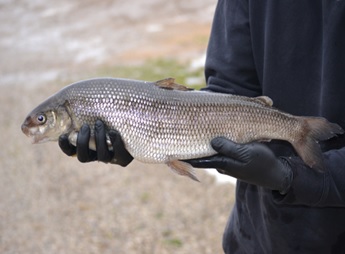Lake whitefish
Introduction
Lake whitefish (Coregonus clupeaformis) is a freshwater fish naturally distributed across Canada and the northern U.S. from the Atlantic coastal watershed west to British Columbia, the Yukon Territory and Alaska. The species can be found throughout most waterbodies in Ontario, including the Great Lakes watershed.
Lake whitefish (Figure 1) hold significant cultural value among Indigenous peoples of North America as a traditional food source and are one of Canada’s most valuable freshwater species in commercial fisheries.
During the past century, lake whitefish abundance has fluctuated significantly in the Great Lakes (apart from Lake Superior) reaching all-time population lows during the late 1960s and early 1970s. Declining populations have been directly correlated with overexploitation, the introduction of invasive species (zebra mussels, quagga mussels and sea lamprey), the degradation of water quality and the deterioration of aquatic habitats.

Lake whitefish are benthivores that feed primarily on invertebrates that dwell on or near the lake bottom. The species spawns in the fall when water temperatures range between 4.5°C–10°C, typically occurring in November or December in the Great Lakes.
Ontario lake whitefish aquaculture
Lake whitefish were first cultured in Ontario at provincial and federal government hatcheries during the late 1800s to enhance commercial fisheries in the Great Lakes and provide a local food source throughout inland regions. Until the 1960s, stocking efforts at government hatcheries focused on the release of early life stages (eyed egg and fry), which would ultimately prove to be an unsuccessful strategy.
In 1981, the Ontario provincial government initiated a Whitefish Culture Project at the Glenora Fisheries Research Station and in subsequent years successfully developed a fully intensive fish culture program capable of rearing the species to advanced life stages. Currently, the Ontario Ministry of Natural Resources stocks lake whitefish exclusively in Lake Simcoe, where the species is stocked at a more advanced life stage (fall fingerling) to preserve the Lake Simcoe genetic stock.
The cultivation of lake whitefish for commercial aquaculture has been limited in Canada. Commercialization and development of the species as a food fish is relatively new in Ontario. In 2016, wild lake whitefish eggs were collected in Georgian Bay as part of a pilot project to see if the species could viably be produced in Ontario. The fertilized wild eggs were incubated at College Boreal in Sudbury and after hatching in 2017 transported to the Ontario Aquaculture Research Centre (OARC) in Alma, Ontario. The cohort was cultured at OARC until attaining a size suitable for transfer and then stocked into a pilot-scale net pen grow-out site located in Lake Huron. To date, these efforts have demonstrated success as lake whitefish fingerlings stocked in a submersible net-pen production system have successfully been grown to market size and harvested.
Species outlook
At the Ontario Aquaculture Research Centre, lake whitefish are cultured for research and for further species development as a food fish. The research centre now holds a captive breeding population and aims to develop a domesticated strain of lake whitefish to support the diversification of Ontario’s aquaculture sector.
Aquaculture efforts in Ontario have demonstrated success in growing lake whitefish in commercial production systems. They are well suited to the freshwater resources found in Ontario, and consumer markets are well established for the species.
More research and development is needed to establish the economic viability of lake whitefish as a food fish species.
Further research to establish a captive breeding population, optimize production practices and develop appropriate commercial diets and fish health strategies will help support production and industry expansion.
References
Ebener, M. P., Kinnunen, R.E., Schneeberger, P.J., Mohr, L.C., Hoyle, J.A., and Peeters, P. 2008. Management of commercial fisheries for lake whitefish in the Laurentian Great Lakes of North America. American Fisheries Society. 4:99-143.
Fisheries and Oceans Canada. 2021. Freshwater Landings. Government of Canada..
Harris, K.C., and Hulsman, P.F. 1992. Intensive culture of lake whitefish (Coregonus clupeaformis) from larvae to yearling size using dry feeds. Aquaculture. 96(7):225-268.
Hart, J.L. 1931. The spawning and early life history of the whitefish, Coregonus clupeaformis (Mitchill), in the Bay of Quinte, Ontario. Contributions to Canadian Biology and Fisheries. 6(1).
Kerr, S. J. 2006. An historical review of fish culture, stocking and fish transfers in Ontario, 1865-2004. Fisheries Sections, Fish and Wildlife Branch. Ontario Ministry of Natural Resources. 1:1-154.
Lasenby, T.A., Kerr, S.J., & Hooper, G.W. 2001. Lake whitefish culture and stocking: An annotated bibliography and literature review. Fisheries Section, Fish and Wildlife Branch, Ontario Ministry of Natural Resources. 1:1-72.
Nalepa, T.F., Mohr, L.C., Henderson, B.A., Madenjian, C.P., and Schneeberger, P.J. 2005. Lake Whitefish and Diporeia spp. in the Great Lakes: An Overview. Publication, Agencies and Staff of the U.S. Department of Commerce. 413(66):3-19.
Scott, W.B., and Crossman, E.J. 1973. Freshwater Fishes of Canada. Fisheries Research Board of Canada. 185:269-277.
Author credits
This fact sheet was authored by Madeline Borland, MSc., aquaculture literature research assistant, and reviewed by Michael McQuire, aquaculture and aquaponics specialist, Ministry of Agriculture, Food and Rural Affairs. Special thanks to Marcia Chiasson, manager, Ontario Aquaculture Research Centre, and Kevin Loftus, Ministry of Natural Resources, (retired) for their contributions.
ISSN 1198-712X, Published December 2023.